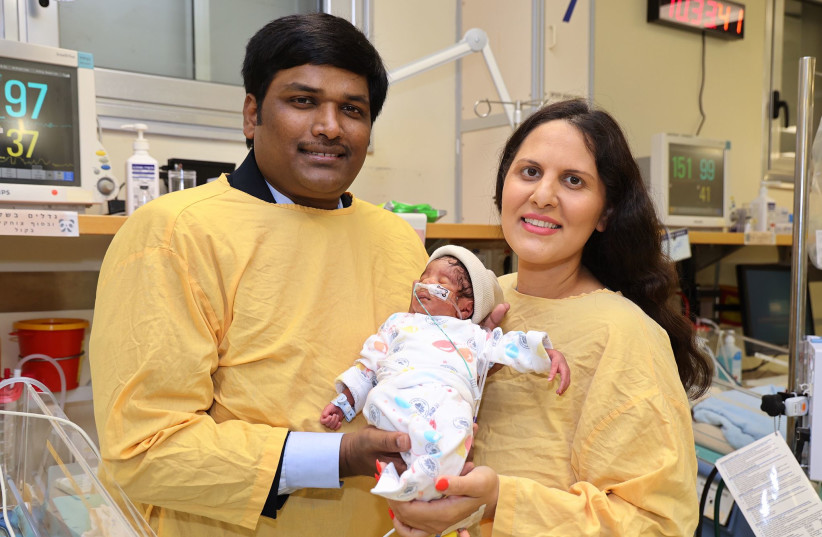Two weeks ago, 38-year-old Tatiana Cohen and her husband arrived at a hotel in Tel Aviv to celebrate their first wedding anniversary, but that romantic night turned into a battle for the lives of Tatiana and the baby in her uterus.
“We went out to a restaurant together that evening and when we came back to the hotel room, I started to feel strong pains in my stomach and nausea – even though I was supposed to deliver the baby in two months, I had an inner feeling that the pains I was having were related to the pregnancy and not to the food I ate in the restaurant. I immediately called the ambulance that took me to Lis Maternity and Women’s Hospital at Tel Aviv Sourasky Medical Center,” she recalled.
The medical team performed a series of tests on Cohen, all of which were normal, but because she was in such intense pain, it was decided to leave her in the hospital for observation. Two hours later, there was a dramatic turn in her condition.
An operating room became a battlefield for the lives of the mother and her son
Dr. Ayelet Dangot, the gynecologist who was in charge of the delivery room on the same shift who was called to treat Tatiana, described how the operating room became a battleground for the lives of the mother and her son: “She was on the verge of passing out, so I realized it was a real emergency. In an ultrasound examination I performed on her, fetal distress was observed, and despite the prematurity of the fetus, we decided to perform an urgent cesarean section. The medical teams of the operating rooms, anesthesia, and delivery were rushed in, and within a few minutes, I pulled out the baby who needed respiration and other treatments. Time is a critical factor, and in emergency cases, if the reaction time is not quick, the consequences can be fateful and even cost the lives of both the mother and the life of the newborn. Fortunately, the exercise of quick judgment is what saved them.”
Dangout explained that an aneurysm of the splenic artery is a weakening and expansion of the blood vessel wall that feeds the spleen. This is a very rare condition that is identified in less than one percent of the population. A rupture of such an aneurysm is a life-threatening emergency that demands urgent surgical intervention and kills about a quarter of patients in whom it is diagnosed. Pregnancy is a risk factor for rupture of an aneurysm, and the risk of mortality increases in such women to about 75%. About 95% of the fetuses do not survive. There is no doubt that this is a great miracle, thanks to the vigilance of the patient and the quick and professional treatment given by the best doctors in the hospital.”

During the cesarean section, the medical team detected massive bleeding in her abdomen and called in additional doctors from the surgical department, including Dr. Nadav Michaan, director of endoscopic surgery at Lis, to locate the source of the massive bleeding.
Dr. Eyal Hashavia, director of emergency surgery who was called from his home in the nearby staff’s housing tower to save the mother’s life, described the case. “I immediately ran to the operating room where there was a tremendous sense of tension during the minutes that passed until we were able to locate the source of the bleeding. It felt like an eternity. After identifying that the bleeding came from a rupture in the splenic artery, we understood the magnitude of the complexity of the operation. We knew we had to everything to save Tatiana’s life and bring her to her newborn son. We started with an emergency operation to open the chest for hemodynamic stabilization, after which we performed the resection of the spleen and tail of the pancreas to stop the bleeding.”
The medical team was able to stabilize her, but Titana was still in serious danger and was transferred to the general intensive care unit for further treatment and observation while she is sedated and ventilated.
A few days after the operation, Tatiana and the baby began to recover quickly and in a way that amazed the doctors. This week there was a first and exciting meeting between the two in the premature-baby ward, and not one eye remained dry: “All these days in the hospital, I didn’t believe I had a baby and that he was alive. It was only when I saw him this week for the first time and held him close to me. I couldn’t stop crying with joy for the miracle that happened to both of us.”
The mother is due to be released from the hospital in the coming days, while her son is breathing independently and is being treated by the premature baby unit staff. He too is expected to be discharged in the coming weeks and be reunited with his family.”
